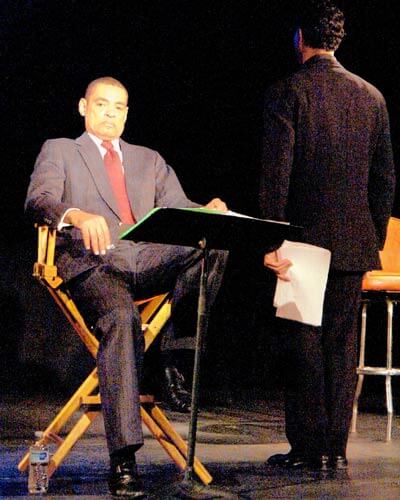Anyone unfamilar with the diversity of Harlem photographer Kwame Brathwaite would marvel at the vast collection he has amassed throughout the 50 years he has been pointing his lens at politicians,entertainers, athletes, world leaders and other celebrated figures.
Those who often spot him squatting on his knees in front of newsmakers fully comprehend that for half a century Brath has earned his place as one of America’s best archivist of African-American snapshots.
Most loyal to his home-base of Harlem, Brath has captured rare images of Muhammad Ali, Malcolm X, Martin Luther King, Adam Clayton Powell, Shirley A. Chisholm, South African President Nelson Mandela, Zimbabwe’s President Robert Mugabe, Liberia’s President Sirleaf Johnson, Cuban leader Fidel Castro, major events at the Apollo Theatre — Little Richard, James Brown, Michael Jackson, Diana Ross, Whoopi Goldberg, President Bill Clinton, Bob Marley etc.
As a matter of fact, Brath was front and center in Zaire in 1974 when James Brown arrived there to perform for the “Rumble In The Jungle” boxing bout that billed George Forman and Muhammad Ali.
When legendary reggae singer Bob Marley died in 1981, Brath traveled to Jamaica to preserve images from the historic send-off. Undeniably, Brath had full access to former South African president when he made his first visit to the United States after his release from 27 years of captivity. Brath was on the scene snapping photographs from Mandela’s arrival at JFK Airport, to a ticker-tape parade to City Hall, on to a mainstage address given at the intersection at 125th St. & Adam Clayton Powell Blvd. to a Yankee Stadium concert and later that day to Gracie Mansion where the heroic leader and his wife Winnie were guests of NYC’s first Black Mayor David N. Dinkins.
Recently, Brath opened his vault for exhibit at Strivers Row GardensGallery, 300 West 135th St. Sparked by the death of two of his most-favored subjects — Michael Jackson and James Brown, Brath selected some of the pictures he has frozen in time. “Gone:But not Forgotten” offers a snippet of his golden years in photography.
“This exhibition was inspired by the recent deaths of a number of perorming artists, particularly James brown and Michael Jackson and the impact of their deaths on the public imagination, and I hope this exhibition, like the music of these musical icons, will leave a lasting impression on a new generation of fans,” Brath said.
The exhibition is open until Feb. 28, 2011.
Finally Perry Finds Poetic Justice From ‘Colored Girls’
Director/actor Tyler Perry has redeemed himself.
After writing. producing and starring in a long list of plays and films where he dressed as a woman to entertain his audiences, Perry in his latest movie stepped away from the starring role to focus his lens on Black women.
In his most challenging release, Perry uses Ntozake Shange’s 1974 choreopoem “For Colored Girls Who Have Considered Suicide When The Rainbow Is Enuf.”
Featuring a stellar cast including Janet Jackson, Kerry Washington, Loretta Devine, Thandie Newton, Anika Noni Rose, Tessa Thompson, Macy Gray, Phylicia Rashad, Kimberly Elise, and Whoopi Goldberg, the film adapts Shange’s classic poems to the travails and perils experienced by Black females of every age. How he uses the narrative of 36-years ago to engage 2010 audiences may be considered his very, first conquest. But that the poetry resonates to comprehension with each scene seems a major victory for the filmmaker who has been heavily criticized for selling buffoonery.
Each actor seems to out-do the other with soulful recitations and soul-stirring revelations.
The men are equally enthralling.
Michael Ealy, Omari Hardwick, Hill Harper, Richard Lawson and Khalil Kain display powerful images of Black males. They deliver riveting performances.
But the film is made for women; specifically colored women of every hue.
Perry’s film leaves lingering and haunting images to ponder.
For those who saw the Broadway production when it debuted three decades ago winning a Tony and Obie Award, there is absolutely no comparison.
Perry deciphers much of the intricacies limited by spoken word and dance.
The comic actor seriously tackles discrimination, poverty, jealousy, rape, abortion, teen pregnancy, the down-low phenomenon, violation of trust, infidelity, religion, war and its ravages, addiction, employer relations, neighbors and their nuances, poverty, affluence and a myriad of issues which confront “colored girls who have considered suicide…”
Perry is the screenwriter, producer and director.
Perry is on target and plu-perfect in his adaptation of this classic presentation.
He has finally found a compatible story that will unite his mostly-female audiences.
Catch You On The Inside!






















